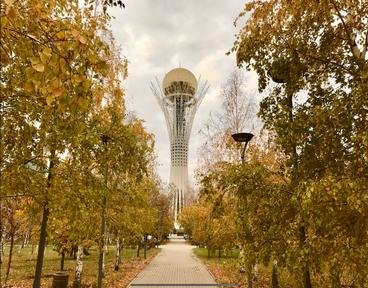Quiz Answer Key and Fun Facts
1. Kazakhstan is the ninth largest country in the world and the largest landlocked country. Bordering or close to Kazakhstan are the central Asian countries of Kyrgyzstan, Tajikistan, Turkmenistan and Uzbekistan.
True or false: Kazakhstan is larger than the area of the other four central Asian countries combined.
2. Many geographers consider Kazakhstan to be part of both Europe and Asia. Which river that empties into the sea at Atyrau forms this border between European and Asian Kazakhstan?
3. Kazakhstan is landlocked but does have a shoreline on a large body of water. If you were in Kazakhstan, where could you go to dip your feet into some salt water?
4. Astana is the relatively new capital of Kazakhstan. Here's a picture of the skyline featuring some fabulous architecture including the National Concert Hall, the Ak Orda Presidental Palace and the Supreme Court. In front of them is an iced over river in the depths of winter. What river does Astana (also known for a while as Nur-Sultan) lie on?
5. The Ascension Cathedral in the photo is located in Almaty, Kazakhstan's largest city. Built in the late 1800s, what is the cathedral made of?
6. Close to Kazakhstan's border with China you'll find the Charyn Canyon. Part of the valley features high walls and unusual stone formations. What name is given to this region?
7. Like many other countries, Kazakhstan has its share of environmental concerns. Which of these issues is a major problem for Kazakhstan?
8. Khan Tengri is Kazakhstan's highest peak. Here's a picture of it at sunset, glowing red in the fading sunlight. Why does the mountain have such a colourful display?
9. 1957 saw the first orbiting man-made device launched from Kazakhstan. Called Sputnik, it was the forerunner of the Space Race which ensued and saw Gagarin, Shepherd, Armstrong, Aldrin and others boldly go where no man had gone before. What is the name of the area Sputnik, Vostok1 and others were launched from?
10. Lake Balkhash in Kazakhstan is a large body of water. What is notable about Lake Balkhash?
Source: Author
Tizzabelle
This quiz was reviewed by FunTrivia editor
Pagiedamon before going online.
Any errors found in FunTrivia content are routinely corrected through our feedback system.

